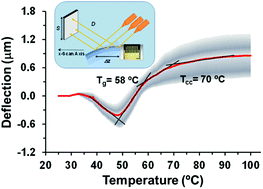Nanofeatures affect the thermal transitions of polymer thin films: a microcantilever-based investigation
Abstract
Nanotechnology is regarded as a promising tool to advance science for a wide range of applications, ranging from nanomedicine, nanoelectronics, imaging and diagnosis. Whilst the unique surface properties of nanostructured materials improve their performance in comparison to conventional materials, little has been done to inspect the correlation between such nanofeatures and the thermomechanical response of nanomaterials. Herein, we report the influence of structural nanofeatures in the glass transition and cold crystallization temperatures (Tg and Tcc) of poly(lactic acid) (PLA) thin films using a technology that detects the microcantilever deflection as a function of temperature. Measurements were conducted on arrays of 8-cantilevers spin-coated with PLA films (thickness of ∼120–200 nm and weight of 6–9 ng) displaying several patterns (compact, nanopored and/or nanoperforated). The Tg increases by 8–13 °C when nanopores and nanoperforations are present, while only the latter affect the Tcc, which increases by ∼6 °C. These phenomena have been attributed (i) the stress of the PLA molecules located at the interface of the pores and perforations, and (ii) to the film-air interface effect, which is associated with the quasi-2D nature of thin films (i.e. those with an aspect ratio of size and thickness greater than 105). On the other hand, the thermomechanical response of PLA thin films loaded with curcumin (CUR) or stiripentol (STP), which formed segregated nanodomains, also differs from that displayed by unloaded PLA films. The size and abundance of CUR and STP nanodomains are directly related to the stress of the PLA chains at the interface and the free volume, which affects the interactions strength and the mobility of polymer molecules (i.e. Tg and Tcc) with respect to neat PLA. Overall, the thermal properties of thin films, which cannot be studied using conventional calorimetric methods, is modified by the presence of nanofeatures. As a consequence, their design needs to be taken into account during the manufacturing of nanomaterials.



 Please wait while we load your content...
Please wait while we load your content...